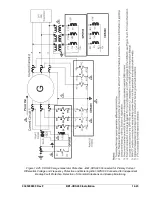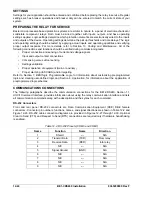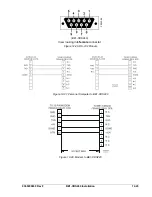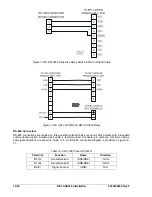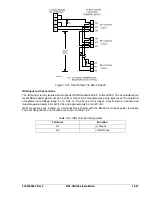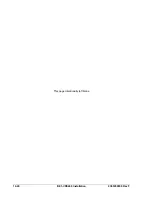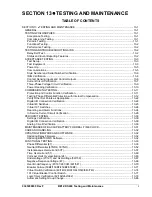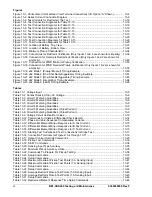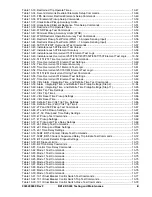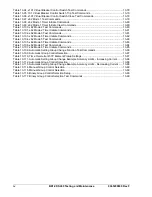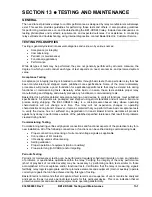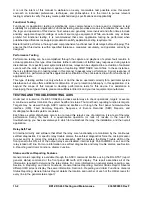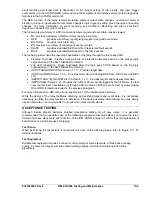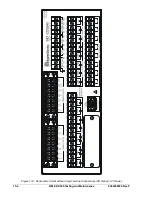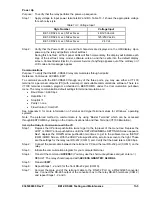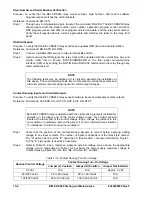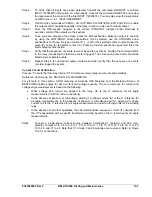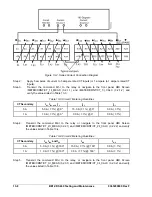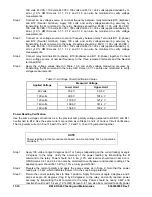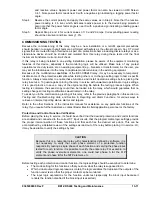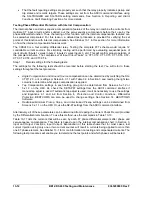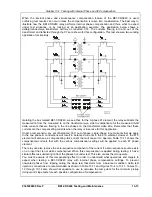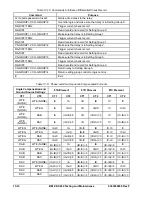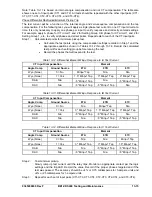
9365200990 Rev F
BE1-CDS240 Testing and Maintenance
13-3
Fault reporting and target data is dependent on the proper setting of trip, pickup, and logic trigger
expressions (via the SG-TRIGGER command) and the assignment of protective elements to be logged as
targets (via the SG-TARG command).
The SER function of the relay records protective element output state changes, overcurrent element
pickup, or dropout, input/output contact state changes, logic triggers, setting group changes and setting
changes. For more information on event reporting, see Section 6,
Reporting and Alarm Functions,
Sequence of Events Recorder Function
.
The following is a summary of ASCII commands where target and event data may be viewed:
RF provides a directory of fault summary reports in memory
RF-#
provides a summary report giving targets, timing and event data
RG-TARG
provides target data only
RS provides a summary of sequence of events records
RS-F#
provides a detailed SER report for the selected fault event #
RS-#
provides a detailed SER report on the last # events
The following summarizes the reporting capabilities of the relay through the front panel HMI:
Flashing Trip LED
: Flashes during pickup of protective elements based on the pickup logic
expression set in the SG-TRIGGER command.
Trip LED
(sealed-in): Stays illuminated after trip logic goes TRUE based on the trip logic
expression set in the SG-TRIGGER command.
\STAT\TARGETS\DETAILS
(Screen 1.1.1): Provides target data.
\STAT\ALARMS
(Screen 1.2.1): Provides alarm data (including BKR FAIL, REC FAIL and REC
LO)
\REPRT\FAULT\M_REC\DETAILS
(Screen 4.1.1.1): Provides targets and fault summary data.
\REPRT\SEQ
(Screen 4.2): Provides the number of new events logged by the SER since the last
new counter reset (resettable only through ASCII command RS=0), events must be viewed using
RS and RS-# commands listed in the previous paragraph.
For more information on HMI menu trees, see Section 10,
Human-Machine Interface
.
While the design of the relay facilitates obtaining and verifying targets and event data, it is not always
necessary to utilize the relay functions to determine if the device operated while testing. You may simply
use an ohmmeter or continuity tester to monitor the output contact status.
ACCEPTANCE TESTING
Although Basler Electric performs detailed acceptance testing on all new relays, it is generally
recommended that you perform each of the following acceptance test steps when you receive the relay.
Performing these steps tests each function of the BE1-CDS240 relay to confirm that no degradation of
performance occurred because of shipping.
Test Setup
When performing the test setups (connections) for each of the following steps, refer to Figure 13-1 for
terminal locations.
Test Equipment
Suitable test equipment requires a minimum of two current source elements, a three phase voltage
source, a source for relay power and contact wetting voltage, and circuit monitoring with timing
algorithms.
Summary of Contents for BE1-CDS240
Page 2: ......
Page 8: ...vi BE1 CDS240 Introduction 9365200990 Rev F This page intentionally left blank ...
Page 38: ...1 28 BE1 CDS240 General Information 9365200990 Rev F This page intentionally left blank ...
Page 40: ...ii BE1 CDS240 Quick Start 9365200990 Rev F This page intentionally left blank ...
Page 152: ...ii BE1 CDS240 Metering 9365200990 Rev F This page intentionally left blank ...
Page 226: ...iv BE1 CDS240 Application 9365200990 Rev F This page intentionally left blank ...
Page 286: ...ii BE1 CDS240 Security 9365200990 Rev F This page intentionally left blank ...
Page 290: ...9 4 BE1 CDS240 Security 9365200990 Rev F This page intentionally left blank ...
Page 292: ...ii BE1 CDS240 Human Machine Interface 9365200990 Rev F This page intentionally left blank ...
Page 306: ...10 14 BE1 CDS240 Human Machine Interface 9365200990 Rev F This page intentionally left blank ...
Page 308: ...ii BE1 CDS240 ASCII Command Interface 9365200990 Rev F This page intentionally left blank ...
Page 342: ...11 34 BE1 CDS240 ASCII Command Interface 9365200990 Rev F This page intentionally left blank ...
Page 349: ...Figure 12 5 Horizontal Rack Mount Front View 9365200990 Rev F BE1 CDS240 Installation 12 5 ...
Page 361: ...Figure 12 17 Typical DC Connection Diagrams 9365200990 Rev F BE1 CDS240 Installation 12 17 ...
Page 372: ...12 28 BE1 CDS240 Installation 9365200990 Rev F This page intentionally left blank ...
Page 468: ...13 92 BE1 CDS240 Testing and Maintenance 9365200990 Rev F This page intentionally left blank ...
Page 512: ...14 42 BE1 CDS240 BESTCOMS Software 9365200990 Rev F This page intentionally left blank ...
Page 544: ...ii BE1 CDS240 Terminal Communication 9365200990 Rev F This page intentionally left blank ...
Page 550: ...ii BE1 CDS240 Settings Calculations 9365200990 Rev F This page intentionally left blank ...
Page 578: ...D 28 BE1 CDS240 Settings Calculations 9365200990 Rev F This page intentionally left blank ...
Page 579: ......



